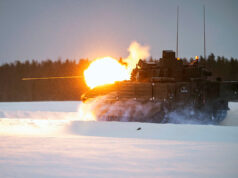The Ministry of Defence has announced plans to award a £125 million contract for the supply of heavy armoured vehicle tracks and associated items, according to a tender notice published on 3 December 2024.
The Defence Equipment & Support Land Equipment Vehicle Support Team (VST), based in Telford, will manage the contract.
The two-year framework, with the option to extend for an additional year, will be awarded to Cook Defence Systems (CDS) as a single-source supplier.
The contract covers the provision of tracks for the UK’s Armoured Fighting Vehicle (AFV) fleet, a critical component for ensuring operational capability and readiness across the Armed Forces.
Key Details
- Duration: 2 years (01 April 2025 to 30 March 2027), with a potential one-year extension.
- Value: £125 million.
- Supplier: Cook Defence Systems (CDS).
- Agent: Babcock Land Defence Limited (BLDL) is acting on behalf of the MOD for this contract.
The VST manages AFV support to sustain the MOD’s extensive land equipment fleet, ensuring vehicles remain operationally effective. This contract reflects the MOD’s continued investment in maintaining and enhancing the UK’s defence capabilities.
Further information can be obtained through the MOD’s Defence Equipment & Support team.
At the UK Defence Journal, we aim to deliver accurate and timely news on defence matters. We rely on the support of readers like you to maintain our independence and high-quality journalism. Please consider making a one-off donation to help us continue our work. Click here to donate. Thank you for your support!














The Ukrainians have said the the C2 and AS90 tracks perform poorly in East European mud, much worse than their Soviet armour. Will these new tracks have taken that feedback into account ?
The high humas content of one to two metres depth and retains water with ideal clay content , not good for tanks as extra sticky. Don’t think any design of tracks would make much difference .
Jack, where did you hear that comment from? I wonder if the Ukrainians have yet removed the rubber track pads to gain greater purchase.
If they take the track pads off they would get better grip
Out of curiosity how are the wheeled vehicles doing in comparison in Ukraine?
The track sections have raised slots which the pads are hammered into and a smooth base . Removing pads would not provide any more grip. Once the slots are worn away you have a smooth metal surfaces which would provide less traction than rubber pads. The sticky nature of the soil is the enemy of tracks and wheels.
Pete, you are going against established thinking here. Removing track pads enables the raised pad housing to bite into the mud.
True, Russian or Soviet armour has a much lower ground pressure due to much wider track foot print. Western armour works well on the Lunerburger Heide which they were designed to do. Yet the mud in the Ukraine and parts of Poland, Slovakia is deep and sticky. A high ground pressure armoured vehicle will sink into it. Just look at history and the German army experiance in WW2.
D63s question on wheeled vehicles in the Ukraine, when I worked in the country I noticed that persons using wheeled vehicles crosscountry would deflate their tyres to have a larger foot print and almost skid over the mud.
One more little issue with operating heavy armour or wheeled armour such as Boxer, mud season is twice a year, late Autumn and early Spring, but Spring is the worst. The only real fighting season for armour is late Spring to October/November, it should be noted that a Ukrainian summer can be 35C+ Winter there is almost no sun, if it is not snowing it’s raining and can have temperatures down to -30C this is cold enough where things including infantry break, I remember icicles in my nose, soon learnt to breath through a scarf. So there can be a 70C temperature swing between a Summer and Winter. Really not good for equipment.
One issue with deflating the tyres to move cross country is that it increases stresses in the tyre wall (which flexes every rotation) western armies “exercise” their vehicles regularly to make sure that they aren’t left standing with one part of the tyre stressed as that can obviously cause localised damage.
One reason alot of the Russian vehicles broke down/got stuck early in the war and then their army stuck to the roads was likely that their tyres were failing when they tried to deflate them and use them off road (I suspect).
deflate the tyres has also be used to improve mobility in the desert by British troops amongst others
Ron, you are saying that tanks cannot operate in winter? That is not correct. In winter the soft deep squelchy mud is gone; the ground is hard. Tanks can operate on hard ground or on none too deep slow.
I was just thinking the same thing…..maybe Making the tracks wider, esp on a 65/75 ton Platform would help with the whole Ground preasure calulation’s a little……but if we are going to go there, then there really “must be” a grown up conversation about the Perkin’s CV-12 V12 diesel 26 litre, 1,200 hp power plant…..when “everyone” else is sporting a 1,500hp unit. Is the 1,200hp plant capable of being “up-graded” to a more powerful state 1,500hp or other wise. I did hear that the cooling system was being looked at, after that “I am in the Dark”. Thanks for your time on this & kind regards P.
That’s half an Armoured Regt.
If tracks where wider the ground pressure would be lower therfore more mobile example ww2 german armour narrow tracks russian t34 wider that was from autumn 1941 to spring 1943
Why is the large MOD using babcock as an agent to then contract another company for the work? Is this normal in procurement?
Back in the day, MoD DE&S contract-trained procurement staff (civil servants) contracted with Industry to acquire track. I agree that it seems odd to now pay a handling fee to Babcock to do this. I can only assume that MoD has reduced their contract-trained procurement staff numbers.